My trip to Israel, Part 2 -- Jerusalem.
I am still an atheist. But I have even more faith in the possibility that just one person, trying to do a little good, can make a difference in the world.
I’ve been home from Israel for more than a week now. Our last stop while traveling was in Jerusalem and I’ve been pondering the 4 days there ever since. While there, the two most important sites we visited were Old City and Yad Vashem — The World Holocaust Remembrance Center.
Ultimately, Yad Vashem had a far greater impact on me than the holy sites in Old City. Though both made me think about my own heritage, my role in the world, my thoughts about how to do good, how to be good and why to even try to do it or think about it at all.
Old City of Jerusalem
For those that don’t know (and I didn’t . . . I literally knew nothing going in so I’m sorry if this feels redundant or condescending — it’s not meant to!), Old City is divided into four quarters — the Jewish Quarter, the Muslim Quarter, the Christian Quarter and the Armenian Quarter.
Old City is home to sites of key importance and holiness to the three major Abrahamic religions of the world. The Temple Mount is a hill in the Old City venerated for thousands of years and thought to be the place where Abraham nearly sacrificed Isaac in the Bible Story. The Western Wall is the holiest place for Jewish people to pray outside of Temple Mount, where there are restrictions for entry. Jews and Christians may visit Temple Mount only as tourists and during restricted hours. The Dome of the Rock is thought to be the place where Muhammad ascended to heaven and al-Aqsa Mosque is one of the oldest mosques in the world and represents the third holiest site for Muslims. Lastly, the Church of the Holy Sepulchre is recognized as the place where Jesus was crucified, then buried, then rose from the dead and it is the holiest site in the world for Christians.
We saw all of these holiest of sites in Old Jerusalem.
I am not a religious person. I’ve been told that some atheists are moved to the point of religious epiphany upon visiting these monuments, pending which is most relevant to their personal family history. Or just out of nowhere.
As a Jewish person (by birth if not practice), I wondered beforehand if I might be moved to religiosity at the Western Wall, often referred to as The Wailing Wall in the West due to the practice of Jewish people crying while praying at the site. I thought it unlikely as my embrace of religion hovers around where Bill Maher’s is, though I in no way share his disdain for the devout.
Many of my closest friends are religious. And I have the utmost respect for their kindness, empathy and desire to do what is right, which is firmly rooted in their religious beliefs. When religion is a means to further kindness and regard for what the religious would call the human soul, I’m filled with respect. Envy even. I wish, at times, I believed. Might it give meaning when it feels like there is none? Probably.
But when religion is used as a cudgel to judge and divide us into bad and good, worthy and unworthy, when it instigates violence or simply the shunning of anyone different (a non-believer), my regard wanes to the point of not existing. In fact, it nears disdain. And yes, the non-religious are guilty of this as well. It seems a human impulse, rather than a religious one, to divide and “other.” As we’ve seen in the past 3 years, a fervent belief in “the science” which was adopted by so many — and then used to divide us into good and bad, believers and non-believers, worthy and unworthy of basic rights — seems a religious impulse on the part of the secular.
This religious impulse — at its best, a desire for a sense of belonging and meaning and a sense of confidence in one’s own moral path — appears to be instilled in us all, even self-declared atheists. But the bad — the certainty and moral righteousness that sanctions the scorn of others — seems all too human as well.
As I’ve shared before and wrote in Levi’s Unbuttoned:
There is no part of my being that believes or wishes to believe in any higher power. I am neither religious, nor spiritual in a secular sense. I don’t like yoga or chanting or praying or seeking. I don’t like being told that there are fixed rules to being a good person. I prefer to make that calculation on my own. I’ve never wanted a framework from religion or any other organized group to tell me how to think, or how to be virtuous, or how to achieve the moral high ground.
So that’s what we’re dealing with here. I respect those who are religious and I have often wished in times of despair that I could find God. But I haven’t. And I can’t. And honestly it all confounds me a bit.
But I’m not a nihilist. I don’t believe in nothing. I don’t believe life is meaningless or pointless. I am not depressed or angry or hopeless. And I don’t want to destroy anything. I believe when I die my life will have been worthwhile, if only for the time it lasted. I’m not terribly afraid of dying. I don’t want to but I know the inevitability of it. And I hope that when the time comes, I’ll know I’ve lived an honorable life, treated my children and husband and parents well, spread a little joy and kindness; that I will have done right by people when it mattered. I hope I will have enjoyed my life and that I have no regrets. I hope I die with nothing left unsaid or undone and can go knowing that what I did was enough.
I hope that when my time comes, I will look back on my life and feel, as my friend Rachael Denhollander has articulated in regards to why she came forward to pursue the conviction of Larry Nassar: “I did it because it was right. No matter the cost, it was right."
I believe in human kindness, and family, and trying to be kind if for no other reason than being kind to another person creates connection and those moments of connection make life worth living. Even if it is fleeting and I’m forgotten the moment I die. I also believe in trying to do the right thing, guided by my own sense of conscience.
As Camus said: I would rather live my life as if there is a God and die to find out there isn't, than live as if there isn't and to die to find out that there is.
So it’s complicated. I don’t believe in God but I think it is worth living as if there was one.
I also don’t believe in living my life in accordance with stories and practices from hundreds of years ago. Hasidic Jewish men wear the clothes of Rabbis from Poland in the late 18th century. The women, out of modesty, must shave their heads when they are married because their hair is apparently too beautiful and makes them too attractive to other men. So they shave their heads, then wear wigs (this makes no sense) or head scarves. No thank you. It all makes no sense to me.
And leads me to the Western Wall in the Jewish Quarter, our first stop in Old City.
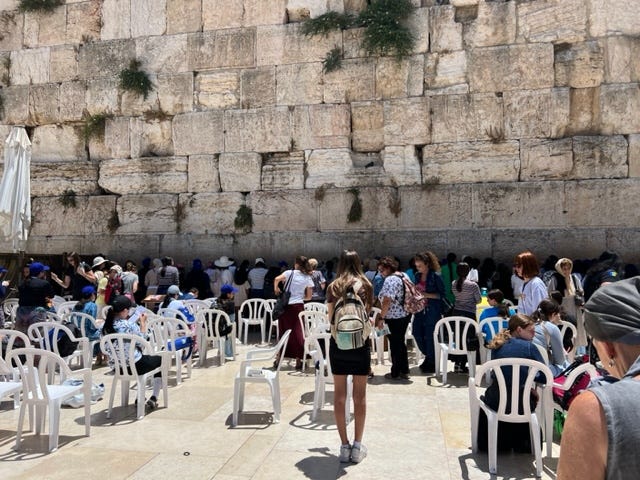
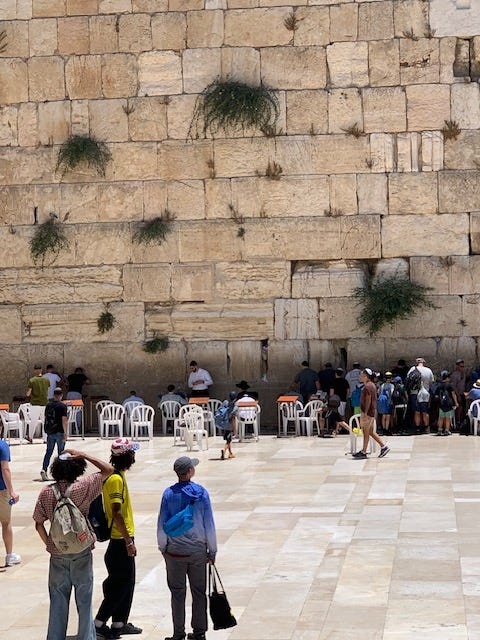
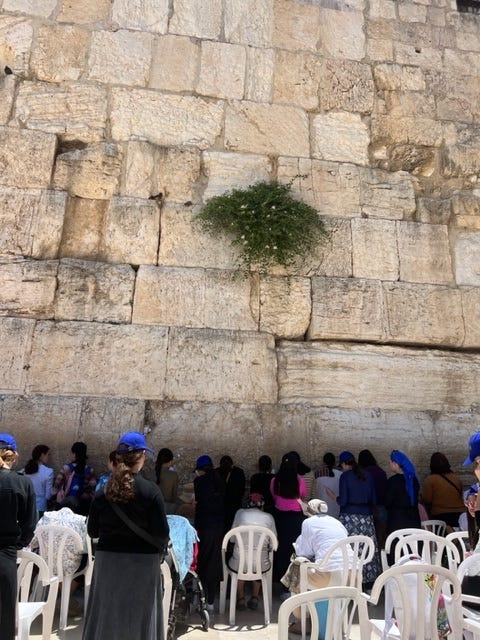
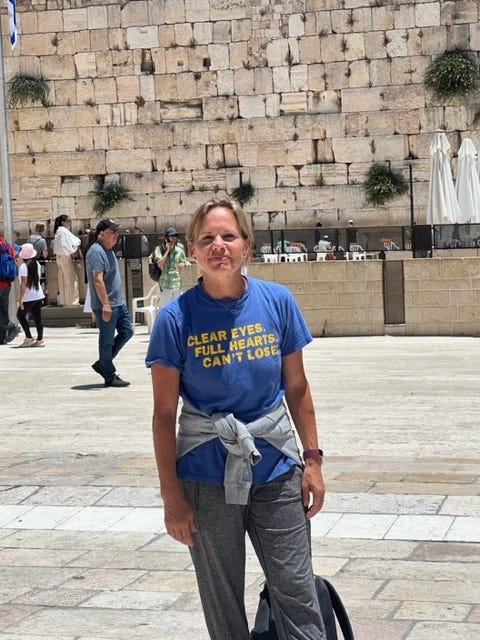
When you arrive in the Jewish Quarter, you enter a security check, lined with armed guards. Understandable given the conflicts in the region, but intimidating nonetheless. As you approach the wall, men and women are divided. The men go to the men’s side, the women go to the women’s side. There are rules about clothing — your shoulders and legs must be covered. But it’s all pretty reasonable. People approach the wall in their gendered lines, and slip notes into the nooks, meant to be prayers to God. The most sacred site in the Jewish faith, lies just behind the Wall.
It was difficult to even get near the Wall. The devout find their place and pray with fervor. They bow their heads into prayer books, they sway or shuckle — as it is called. They bend and bow and cry and shake with their entire bodies and they seem to be transported. Transcendent. Not me. I observed, respectfully. I placed a note with my daughter, but into the ether, not to God per se.
It all seemed odd to me. By odd, I mean just not something I can relate to. Something not relevant to me. The swaying, the transcendence, the separation of men and women. But I went with the custom if not the swaying, was respectful and interested.
I’m rarely, if ever, overcome (my nickname as a gymnast was The Stoic) and I’m intrigued by others who are. Ultimately, I was not transformed. I’m the same old non-religious person I was before I entered the Jewish Quarter of Old Jerusalem.
On to the Muslim Quarter . . .
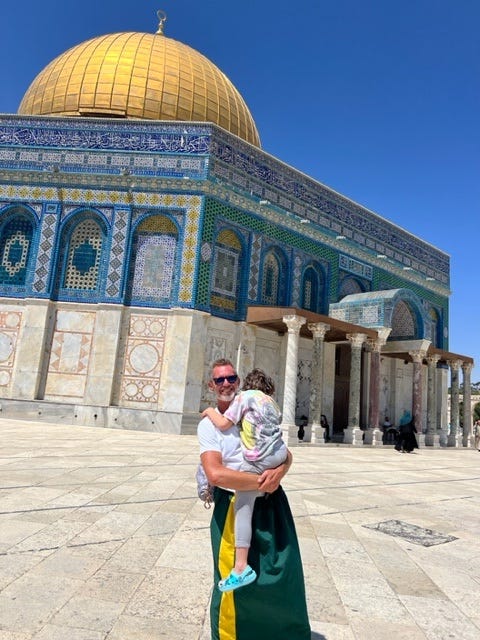
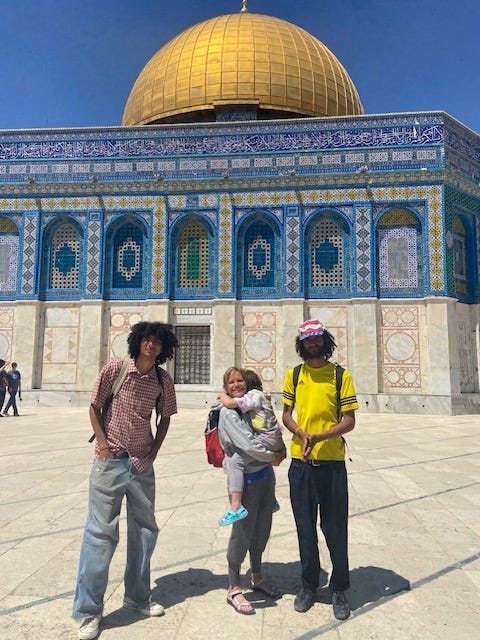
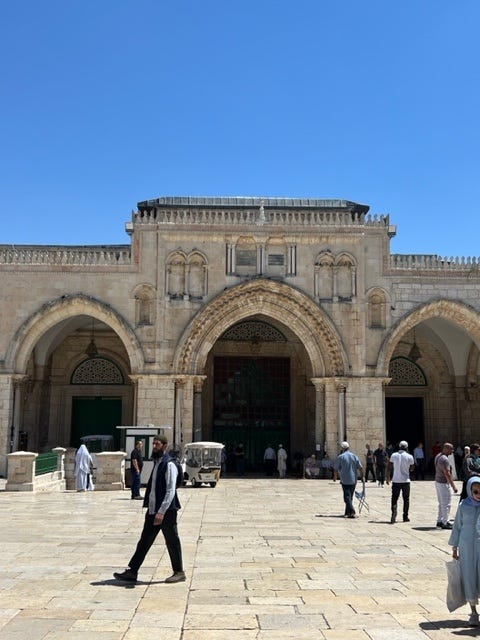
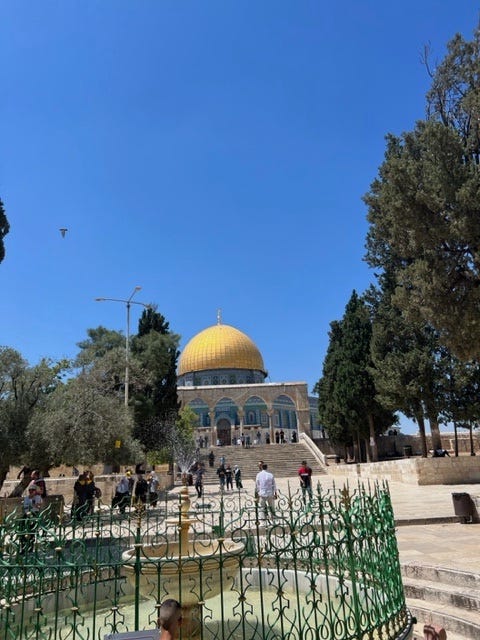
The key holy sites in this quarter are The Dome of the Rock and al-Aqsa Mosque, all on The Temple Mount. The Dome of the Rock is an Islamic shrine at the center of the al-Aqsa Mosque compound on the Temple Mount. Unless you are Muslim, you cannot enter Dome of the Rock.
There are serious rules and more security in this section. More armed guards (again, understandable given the conflict in the region), and lots of screaming to ensure adherence to the customs. You must be covered. Arms, legs, ankles. I wore a hoodie and sweat pants in 100 degree heat. Men are meant to cover their heads. My husband is wearing the “modesty skirt” they provide, in the top right picture above. We were warned by our guide not to hold hands with another adult, or to put an arm around another adult for a photo. It’s ok to hold a small child’s hand. Or hold a small child — as my husband is doing in the photo above on the top left, and as I am doing in the top right photo. But we could not hold hands. Fine, I don’t need to.
There were confrontations when a hood or hat slipped off of a man’s head. I know my husband’s is not covered in the photo — talk to him. It was all very stressful. Amazing to see and experience, but I was relieved to move on to the Christian Quarter.
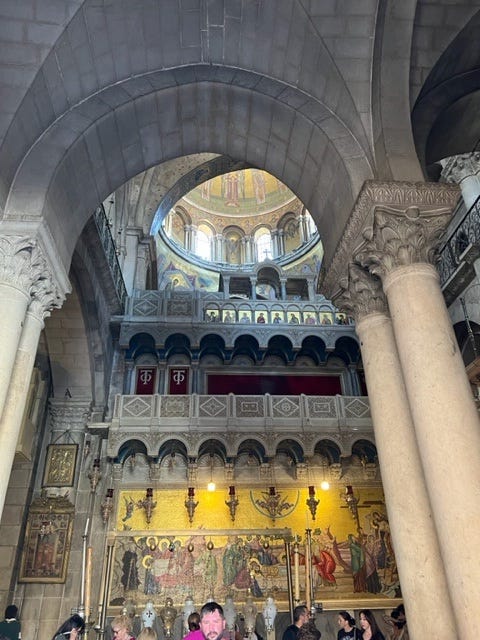
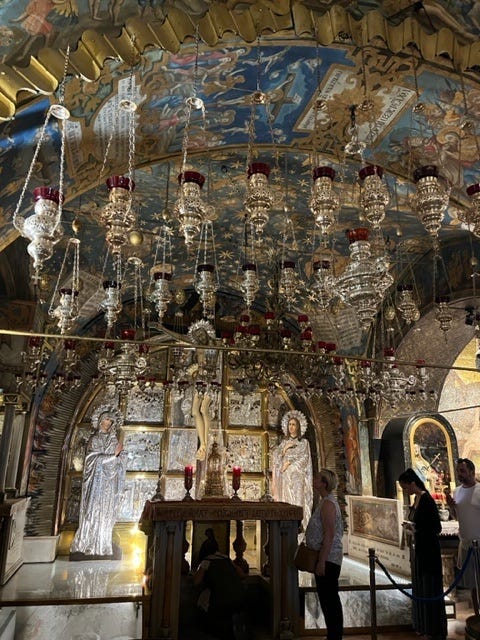
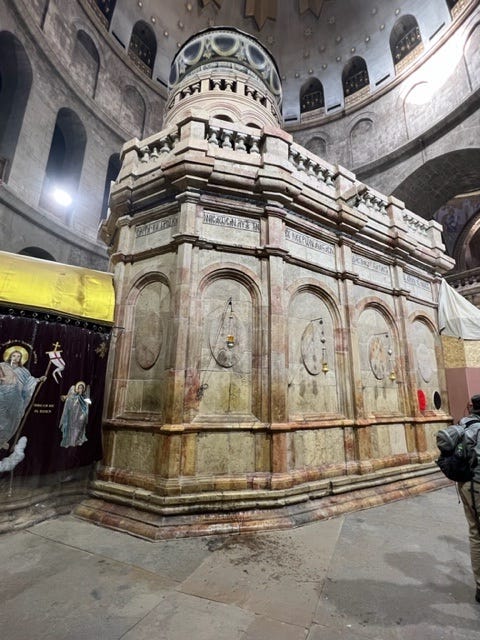
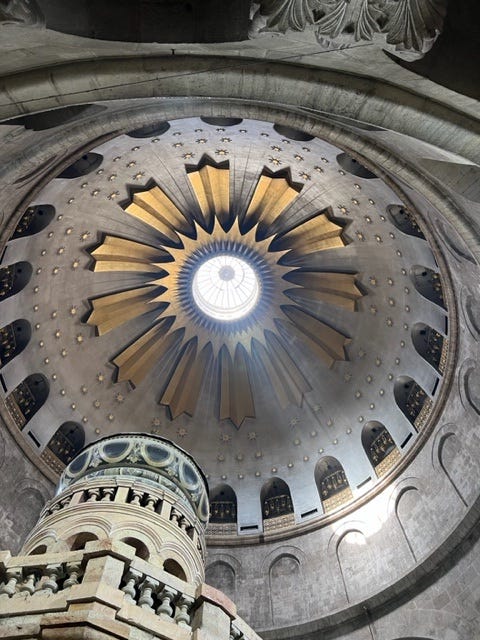
The Christian Quarter is built around the Church of the Holy Sepulchre and contains two sites considered holy for Christians — the site where Jesus was crucified and Jesus’ empty tomb. You walk the Via Dolorosa, a processional route that represents the path Jesus took to his crucifixion.
There was no separating men and women, there were no wardrobe requirements or restrictions. There was praying. It was passionate but quiet and seemed like less of an out of body experience that those at the Western Wall. It all felt a bit more relaxed than the first two quarters, which was a relief. I was interested in the history, here and the other quarters. But — and don’t hate me — it was not emotional for me. None of it. In fact, it reaffirmed my atheism.
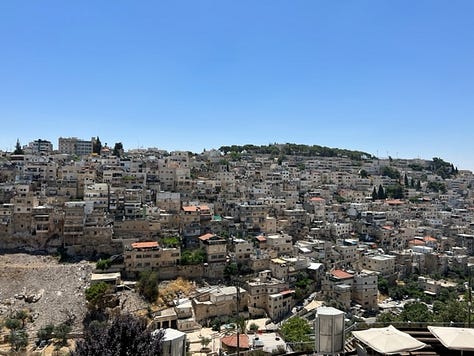
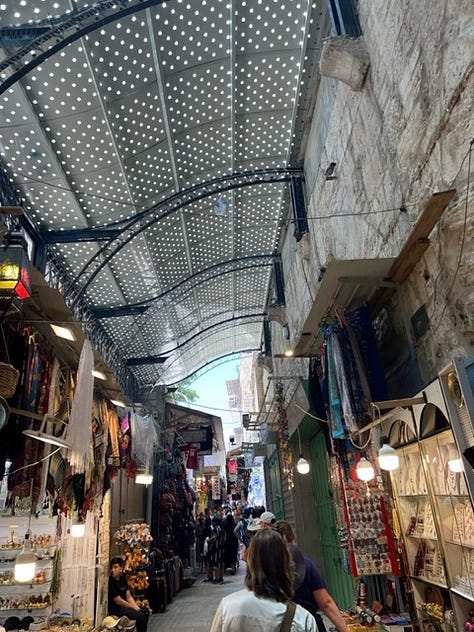
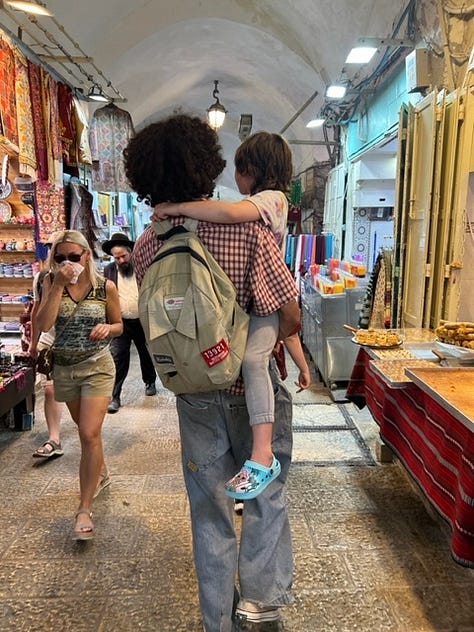
Which leads me to Yad Varshem . . . this was the only time on our trip I was brought to tears. It’s a beautiful museum as a monument in and of itself. But it is gruesome. Children ten and under are not allowed inside. Only in eighth grade do Israeli school children begin making trips to the site.
I visited the museum with a member of my family whose mother is a Holocaust survivor. She found the records of the woman who saved her mother, and who her oldest child is named after. I can’t imagine what that felt like for her.
The part in the tour of the museum that I was most struck by was the “Righteous Among the Nations” — those who risked and sometimes gave their lives to protect their Jewish neighbors. Our guide told us that .5% of people were avid believers, turning in their neighbors. And .5% actively tried to save others, fought back, saw the evil for what it was and vowed not to submit to it. They would have died themselves rather than be overtaken by such evil. And many did just that.
The other 99% went along. They were quiet in the face of unimaginable hatred and violence and destruction, the intended annihilation of a people for their beliefs. Some, one might imagine, just hoped to go unnoticed. They hoped to stay quiet in the shadows and evade capture, death. They stayed quiet to protect their own families, while allowing for horrific atrocity to be visited upon their fellow humans.
As we all know, six million Jews were murdered in the Holocaust, a rough estimate as the real number is virtually impossible to document. They were shot, gassed, dumped into pits, they were starved and tortured, robbed of their belongings before being murdered. And most stood by hoping they wouldn’t be next.
The courage of those who resisted, who saved a life before losing their own, resonated deeply with me. Would I have the courage of my convictions to do the same? I hope so. I don’t know. Clearly the vast majority do not. Why would I be any different than the 99% who went along? Why would any of us?
Could I do what Aristides De Sousa Mendes did? He was a Portuguese diplomat who issued transit visas to those needing to escape. He died alone and poor, unable to support his large family. But, it is estimated, that he saved tens of thousands of lives.
Before he died, he said: “I could not have acted otherwise, and I therefore accept all that has befallen me with love.”
His selflessness, his kindness, and the way that it represents all that is truly good about the human spirit, is what ultimately moved me to tears. And connected me to my own history, heritage, family and humanity. (My ancestors hail from Odessa and other parts of eastern Europe. Second and third cousins of my great aunts and uncles died in camps but we know little about them. My great grandparents all made it to the United States by the 1910s and 1920s.)
The woman who saved my relative’s mother refused to receive recognition as “Righteous Among the Nations” because she believed her behavior was in no way out of the ordinary. The facts tell another story. She was, in fact, extraordinary.
The exit of Yad Vashem opens up to a wide, bright landing looking out over the Jerusalem hills, an invitation for Jewish people to know and understand they will always have a safe home in Israel, should they find themselves in danger.
I have no interest in living in Israel, or making “aliyah,” as it is called. But I am grateful to have visited, to feel a stronger connection to my own family’s history, and to be reminded of the generosity of the human spirit, even in the face of unfathomable evil.
I am still an atheist. But I have more belief in the notion that good triumphs over evil. And I have the utmost faith in the possibility that just one person, trying to do a little good, can contribute to that aim and make a difference in the world.




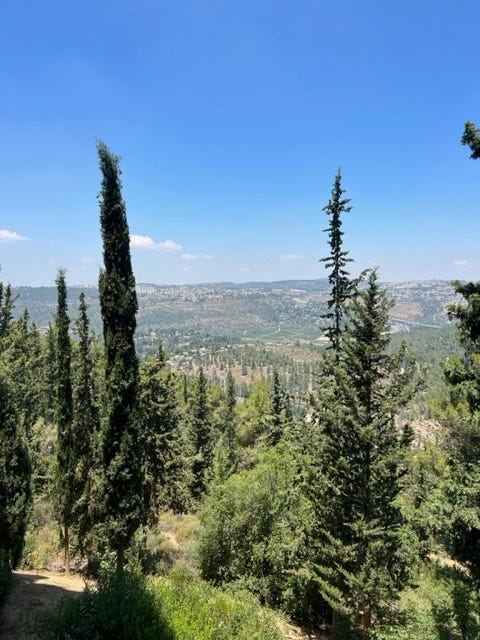
Jennifer. I read your post prior to leaving for Israel, and noted in a comment that I had a very similar experience with Judaism as you did growing up. I later married a Jew who was slightly more devout than I was, but had actually been Bat Mitzvah’ed in Jerusalem when she was of age. She had resolved, and I was on board, with doing the same for our children. My first trip to Jerusalem was when our older daughter had her Bat Mitzvah. I can say, like you, I did not become more religious as a result of the experience, but I did become more connected to Israel. The place blew me away. In fact, I think I was just as amazed in Bethlehem as I was in Israel. And, it was as much about the observation of the devotion of people to their religion (all three) as it was about the structures, or even the history.
One of my favorite pictures that I took was of the people heading down to the manger site in the Church of the Nativity in Bethlehem. Every color, race, gender, dress, etc. of person waiting to go through the entrance seemed to be equally intense. Our guide in Bethlehem was a Palestinian Christian (Jews not permitted since it’s an Arab city).
One other point I’d like to make. Like you, my ancestors came to the US from Eastern Europe well before the Holocaust. I had no knowing connection personally to anyone who perished in Europe during WWII. So, the Holocaust history was as much about man’s inhumanity to man as it would be to a non-Jew. But, I wanted to learn more about what caused all these Jews (like your and my ancestors in Eastern Europe) to come to the US and other parts of the world (including Israel). There is an amazing multi-part podcast by a guy named Daryl Cooper (aka MartyrMade) called Fear and Loathing in the New Jerusalem. Now that you’ve been there, I am confident you will be immersed in the history of the pre-War (WWI) times there. I encourage you to check it.
Raised but not practicing Catholic here. Being raised in a “religion” with loving parents set my moral compass. Appreciate history of all religions and quite simply live by the ‘Golden Rule’.
Although you need to give yoga a second chance. Great exercise for old guys like me. If/when there is a ‘mindfulness’ time, you can be thinking about anything- your next article topic, what you want for dinner, or nothing at all, that’s my go-to. Thanks for the trip to Israel!!!